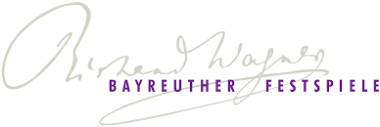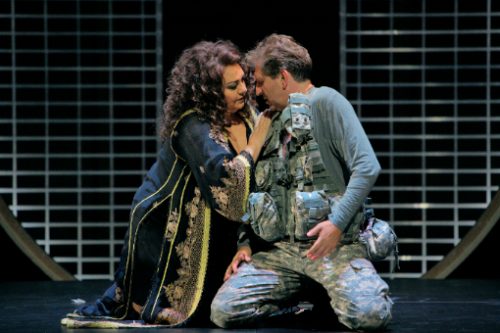
 Germany Bayreuth Festival 2019 [3] -Wagner, Parsifal: Soloists, Chorus and Orchestra of the Bayreuth Festival / Semyon Bychkov (conductor). Festspielhaus, Bayreuth, 15.8.2019. (JPr)
Germany Bayreuth Festival 2019 [3] -Wagner, Parsifal: Soloists, Chorus and Orchestra of the Bayreuth Festival / Semyon Bychkov (conductor). Festspielhaus, Bayreuth, 15.8.2019. (JPr)

(c) Bayreuther Festspiele/Enrico Nawrath
Production:
Director – Uwe Eric Laufenberg
Sets – Gisbert Jäkel
Costumes – Jessica Karge
Lighting – Reinhard Traub
Video – Gérard Naziri
Chorus conductor – Eberhard Friedrich
Cast included:
Amfortas – Ryan McKinny
Titurel – Wilhelm Schwinghammer
Gurnemanz – Günther Groissböck
Parsifal – Andreas Schager
Klingsor – Derek Welton
Kundry – Elena Pankratova
My remaining two nights at this year’s Bayreuth Festival were for the operas that were having their final outings in their current productions. Firstly, it was Uwe Eric Laufenberg’s Parsifal that will live long in the memories of those who have attended Bayreuth over the years because of the combination of rumours about its religious imagery and a spate of terrorist atrocities – in Germany and elsewhere in 2016 – which led to a tightening of the security arrangements on the Grüner Hügel. Still to this day it means access to the Festspielhaus requires a peak level of fitness in order to walk down through the car park or up through the surrounding grounds. This always reminds me of why Wagner built it there in the first place: he needed it to be far enough from Munich so only the most devoted and dedicated to his music would want to undertake the journey (or pilgrimage?). So, in 2019 it remains plus ça change, plus c’est la même chose!
Not for the first time this summer my reaction was that the sheer beauty of the orchestral playing and the singing of the magnificent chorus distanced me somewhat from the stage pictures of this Parsifal. For Act I began – as ever – in roughly modern times in a battle-scarred church in southern Iraq. Wagner’s knights are Christian monks in their habits and their leader, Gurnemanz, has a knitted cap and spectacles and looks like an Imam. During the Prelude we see they have given refuge to the dispossessed sheltering from Isis who soon pick up their beds and belongings to leave the church. Soldiers are then seen wandering in and around but don’t appear threatening. Throughout Laufenberg’s Parsifal all religions appear to be coexisting peacefully unlike, unfortunately, in our real world!
Amfortas will be shown bathing in a huge baptismal font and Laufenberg needs the audience to make the connection between him and the image of Christ taken down from a crucifix near the beginning of the opera: this was shown being venerated and wrapped in a shroud before being removed to a side chapel. This has heightened significance near the end of the act when a half naked Amfortas has a crown of thorns and his side pierced to provide the blood which apparently will renew the brotherhood. As I have written previously, this mirrors the supposed words of Christ: ‘This is my blood of the covenant, which is poured out for many for the forgiveness of sins.’
When Parsifal shoots the swan – offstage – a young boy in red T-shirt and short trousers falls dead onstage. This is another powerful image as he has apparently been felled by a ricocheting bullet. He is taken away and Parsifal comes on with his crossbow and we see the familiar rather unrealistic white swan. Titurel unusually appears onstage to preside over the Grail Ceremony. Kundry, who of course does very little in this act, wears a burka and ‘Zum Raum wird hier die Zeit’ brings us a simply stunning few minutes of videography from Gérard Naziri when we leave the Earth, seemingly head out beyond our own galaxy, before returning.
Act II begins in a hammam presided over by Klingsor in a skirt-cum-kilt who we first see praying towards Mecca. He appears to be holding Amfortas hostage – is this ‘real time’ or part flashback? – and he will later be seen ravishing Kundry. From an upper room with a large array of crucifixes we see Klingsor (who suggestively wields a crucifix with a phallus shaped end) spying on both Kundry and Parsifal. Later he is discovered self-flagellating and so Klingsor can watch but cannot take part because, as the story tell us, he has self-castrated himself.
Flowermaidens are initially in burkas that they take off to appears as harem girls. Parsifal enters looking like a military sniper and is soon stripped of his combat gear and gets bathed by the girls. It still is very odd how Laufenberg has Kundry and Parsifal leave the stage when the other has their big Act II moment. At least near the end this gives Parsifal the chance to put his uniform back on before Klingsor eventually interrupts proceedings and relinquishes the spear – he originally captured from Amfortas – much too easily. Parsifal breaks it to make the sign of a cross with the broken pieces and evil is banished as all Klingsor’s crucifixes fall to the stage.
For Act III, several more years have passed, and we are in a smaller even more derelict chapel and the natural world is a reclaiming the ruins. Gurnemanz gets the ‘holy’ water he needs from a fridge acting as ‘die heilige Quelle’. Both Gurnemanz and Kundry have aged markedly: he occasionally resorts to using a wheelchair, she is stooped and has a tremor. Parsifal enters dressed all in black looking for all the world like an Isis soldier. For the Good Friday Music (Karfreitagszauber) young people dressed like eco travellers enter and frolic naked under a waterfall at the back. As Parsifal absolves Kundry of her sins she is venerated by future generations. More impressive video shows the tolling of a bell and the baptism in rushing waters of three Wagners: Winifred, Wolfgang and Richard himself!
Everything opens up and we back in the original church setting as in Act I although Richard Lorber in the programme suggests Laufenberg is exploring ‘the theme of the Festival Theatre itself as a problematic venue, having been elevated to the status of a temple by Cosima Wagner and her associates’. Titurel’s coffin is brought on. Amfortas refuses to shed blood despite the protestations of his knights and a throng of devotees and zealots of all the world’s major religions. When Parsifal – now having the appearance of a modern-day preacher – brings back the spear and throws it into the coffin, everyone else follows suit with their religious artefacts and clothing. At the conclusion of this Parsifal the houselights go up and I have always taken this to query ‘Weisst du, was du sahst?’ (‘Do you know what you saw?’). Everyone onstage wanders into a slight haze as if confirming that the future is in our own hands.
The glory of this Parsifal was Semyon Bychkov’s masterly control of the remarkable Bayreuth Festival Orchestra and his total understanding of the score’s sweeping arc: it was noble, with just the correct balance of spirituality and reverence. Although it seemed swift, it wasn’t too swift.
Festival favourite Günther Groissböck (Wotan in the 2020 Ring) was a paternal Gurnemanz and his expressive voice allowed greater involvement in his long Act I narration than sometimes seems possible. As Amfortas, Ryan McKinny sang the great cry of ‘Erbarmen!’ with equal amounts of anguish and anger and elicited compassion for his character’s suffering. Elena Pankratova is not one of the most vocally or physically alluring of Kundrys but is a compelling singing-actor, although when her character has only the two words in Act III she overacted as if channelling Stanislavski who said ‘There are no small parts only small actors’! Derek Welton scowled with evil intent and was a firm-voiced wizard Klingsor; whilst Wilhelm Schwinghammer brought a cavernous sound to Titurel’s portents. As ever, the Flowermaidens had well-balanced voices and danced and sang as if they were really enjoying themselves.
I suspect I am in a minority about Andreas Schager – another favourite of the Bayreuth audience – who, for me, sings every Wagner role with the same loud, Tristan-like, trumpeting tones. I prefer a voice capable of soaring to more ethereal heights and bringing more profundity to the final scene from ‘Nur eine Waffe taugt’ onwards.
Jim Pritchard
For more about the Bayreuth Festival click here.